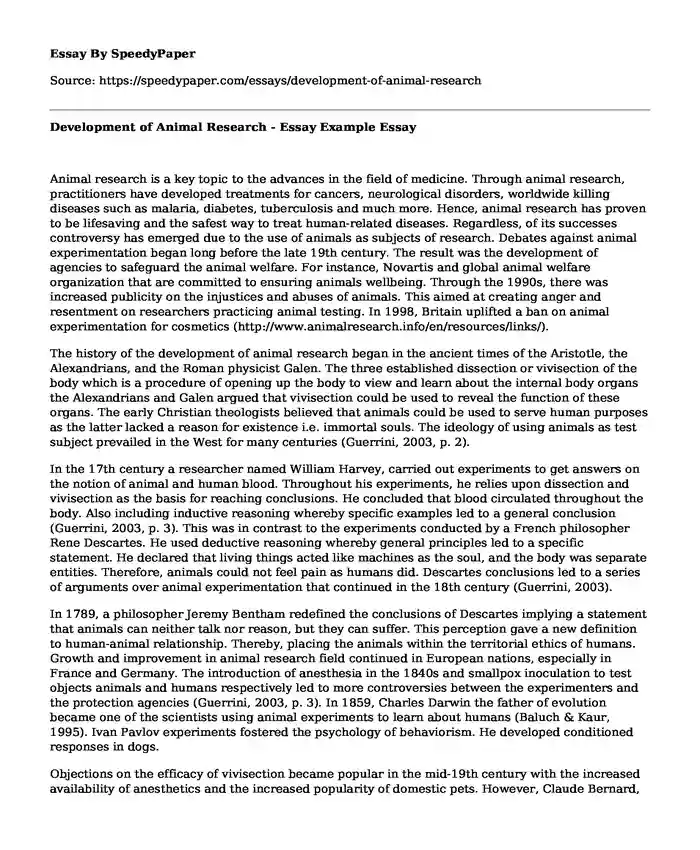Animal research is a key topic to the advances in the field of medicine. Through animal research, practitioners have developed treatments for cancers, neurological disorders, worldwide killing diseases such as malaria, diabetes, tuberculosis and much more. Hence, animal research has proven to be lifesaving and the safest way to treat human-related diseases. Regardless, of its successes controversy has emerged due to the use of animals as subjects of research. Debates against animal experimentation began long before the late 19th century. The result was the development of agencies to safeguard the animal welfare. For instance, Novartis and global animal welfare organization that are committed to ensuring animals wellbeing. Through the 1990s, there was increased publicity on the injustices and abuses of animals. This aimed at creating anger and resentment on researchers practicing animal testing. In 1998, Britain uplifted a ban on animal experimentation for cosmetics (http://www.animalresearch.info/en/resources/links/).
The history of the development of animal research began in the ancient times of the Aristotle, the Alexandrians, and the Roman physicist Galen. The three established dissection or vivisection of the body which is a procedure of opening up the body to view and learn about the internal body organs the Alexandrians and Galen argued that vivisection could be used to reveal the function of these organs. The early Christian theologists believed that animals could be used to serve human purposes as the latter lacked a reason for existence i.e. immortal souls. The ideology of using animals as test subject prevailed in the West for many centuries (Guerrini, 2003, p. 2).
In the 17th century a researcher named William Harvey, carried out experiments to get answers on the notion of animal and human blood. Throughout his experiments, he relies upon dissection and vivisection as the basis for reaching conclusions. He concluded that blood circulated throughout the body. Also including inductive reasoning whereby specific examples led to a general conclusion (Guerrini, 2003, p. 3). This was in contrast to the experiments conducted by a French philosopher Rene Descartes. He used deductive reasoning whereby general principles led to a specific statement. He declared that living things acted like machines as the soul, and the body was separate entities. Therefore, animals could not feel pain as humans did. Descartes conclusions led to a series of arguments over animal experimentation that continued in the 18th century (Guerrini, 2003).
In 1789, a philosopher Jeremy Bentham redefined the conclusions of Descartes implying a statement that animals can neither talk nor reason, but they can suffer. This perception gave a new definition to human-animal relationship. Thereby, placing the animals within the territorial ethics of humans. Growth and improvement in animal research field continued in European nations, especially in France and Germany. The introduction of anesthesia in the 1840s and smallpox inoculation to test objects animals and humans respectively led to more controversies between the experimenters and the protection agencies (Guerrini, 2003, p. 3). In 1859, Charles Darwin the father of evolution became one of the scientists using animal experiments to learn about humans (Baluch & Kaur, 1995). Ivan Pavlov experiments fostered the psychology of behaviorism. He developed conditioned responses in dogs.
Objections on the efficacy of vivisection became popular in the mid-19th century with the increased availability of anesthetics and the increased popularity of domestic pets. However, Claude Bernard, a French physiologist, was among the first to argue for the use of animals in research in his work, Introduction to the Study of Experimental Medicine. He argued that the sacrifice of animal lives was essential to the advancements of medicine, which meant the alleviation of human suffering and the thus the prolonging of human life. Other scientists, including Jeremy Bentham, were of a contrary opinion. They argued animals had the capacity to experience pain, pleasure and suffering and if any action minimized pleasure and maximized pain, then it was subject to moral disapproval (Sharp, 2004).
The Society for the Protection of Animals Liable to Vivisection was formed in 1875 and emerged as a leader in the anti-vivisection movement. It led to the establishment of the Cruelty to Animals Act of 1876, which required the use of anesthetics for various types of animal experimentation (Sharp, 2004). The success of the Act was short-lived with the development of a rabies vaccine and the treatment for diphtheria as a result of animal testing providing compelling evidence on the health benefits that can result from the practice.
In modern times, the rise of animal rights organizations like the Animal Liberation Front and People for the Ethical Treatment of Animals (PETA) has led to significant changes in policies concerning animal experimentation. As of 2010, the National Institutes of health seized the use of chimpanzees in medical experiments and directed the Institute of Medicine to study whether such experiments were even needed. The directive culminated in the release of 50 chimps that were biomedical research subjects to sanctuaries. The U.S. Fish and Wildlife Service also listed chimpanzees on the endangered species list, effectively banning them from invasive medical research.
In conclusion, animal testing is likely to decrease in future as alternatives continue to be developed. Furthermore, stringent regulations put in place holding those accountable in animal testing. In addition to this, the animal activist will not stop in their quest against animal testing. (Baluch & Kaur, 1995)
Works Cited
Baluch, B. & Kaur, a. B., 1995. Journal of Psychology. "Attitude Change Toward Animal Experimentation in an Academic Setting'', p. 477.
Guerrini, A., 2003. Experimenting with Humans and Animals: From Galen to Animal Rights. s.l.:JHU Press.
Sharp, R. R. (2004). Ethical Issues in the Use of Animals in Biomedical Research. Baylor College of Medicine.
Cite this page
Development of Animal Research - Essay Example. (2019, Jun 26). Retrieved from https://speedypaper.net/essays/development-of-animal-research
Request Removal
If you are the original author of this essay and no longer wish to have it published on the SpeedyPaper website, please click below to request its removal:
Popular categories





